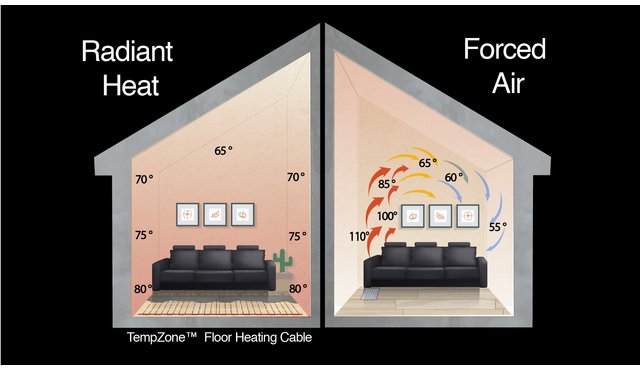The pros and cons of radiant heat experts agree that for comfort in winter no other technology comes close to matching the performance of radiant floor heating.
Electric radiant ceiling heat pros and cons.
Energy efficient electric radiant floor heating systems are generally very efficient and use as much or less energy than other heating systems.
4 electric radiant floor heating pros and cons radiant floor heating.
They are a good solution if you only want heated floors in certain rooms.
Pros of radiant floor heat.
One medium sized room may add approximately 2 000 2 500 to your monthly bill.
Here are some pros and cons to think about before committing to it.
Our electric radiant ceiling heating system also eliminates cold and hot spots throughout the environment.
Both provide heating in a room from the floor up for consistent efficient warmth.
Electric radiant heating systems are more affordable to install but energy bills will be substantial in the long term.
But if you re building a new home and wish to have heated floors throughout you should consider either electric slab heating cables which can be installed directly in a concrete slab or a hydronic floor heating system.
There are pros and cons to having radiant ceiling panels and this article will address several of them.
Most electric floor heating systems use 12 watts per hour per square foot meaning a 100 square foot room would use 1200 watts in total every hour or 300.
Warm water systems run hot water through pipes to create heat whereas electric underfloor heating heats wiring beneath the floor to generate heat.
Electric radiant floor systems which come as mats that can be easily installed underneath the flooring from below.
There are two types of radiant floor heating electric and water based systems.
Disadvantages limitations problems and cons of electric cable ceiling heat same problems as other forms of electric heat since the cables wires in this type of ceiling heating heat by electrical current resistance this is indeed a specific form of electric heat and suffers just about all the drawbacks of it.
One of the big advantages of radiant ceiling heat is that it will not dry out the air in your house like a forced air system does.
Here are some of the pros and cons of radiant ceiling heat.
However if you aren t investing in a big remodel this option may be wise.
Radiant ceiling panels are starting to become popular as a way to better heat a home.
A direct transference of clean even heat from object to object without fans pumps or hoses silent motionless and invisible.
In fact the temperature variant from ceiling to floor is only about 1 c 2 f.
Pros and cons of radiant heat.




























